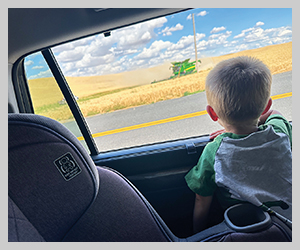

Sam Kimmell has been a crop advisor with The McGregor Company for nine years. He typically works with about 30 farms every year, helping them make planting and crop input decisions. He grew up on a farm in North Idaho, but after high school, joined the Navy. He and his wife returned to Eastern Washington when they bought his wife’s family farm in Endicott, Wash. We had some questions about crop advisors and what they did, particularly in the spring.
What is a crop advisor?
Basically, they are experts who take locally developed or globally developed solutions and tailor them to fit specific farms or environments in their local area to help farmers determine what is needed to raise a profitable crop. Really, it is all just problem solving, whether that’s an environmental problem, an economic problem, or a logistical problem; it’s a daily problem-solving exercise. You have a problem and a solution, and how do you make the two match up?
What do crop advisors do in the spring?
For winter wheat, which is planted in the fall, we begin by looking at the overall health and viability of the crop. With the cold weather and unpredictable winters we’ve had, often times, there’s something new every spring that gets thrown at us, whether that’s winterkill or a disease. We will be looking at root development, erosion, environmental factors, and pest pressure. One of the big things we look at in winter wheat is the development of the main tillers to determine if the crop is deficient and needs top dressing (fertilizer). We also do lots and lots of soil tests so we can get an idea of where the nitrogen is sitting in the crop that is in the ground.
What about for spring-planted crops?

With spring-planted crops, the timing is more compressed; we have to do it all at once. We’ll do soil tests to see what the health of the soil is, and what the plants will require. We’ll decide if we need a herbicide application prior to planting to kill problem weeds. Oftentimes, seeding and fertilizing will take place at the same time. If I’m able to, I will be there when the field is seeded so I can monitor the depth the seed is being planted at and how many seeds are being planted. We’ll continue monitoring those fields as the seeds germinate.
As spring progresses, we will be monitoring the health and pest pressure of both fall- and spring-planted crops and having daily conversations with our farmers about what they and we are seeing.
How do you keep track of all these different fields and what’s been done to them?
Like my grandpa said, the best thing about farming is you get to try again every year, and the bad thing about farming is that you have to try every year. I’ve learned to take good notes. In addition, our industry has a rich history, and you are often dealing with a farmer who has generations of previous experience and knowledge about their land.
What kind of education do crop advisors usually have?
An ag or science degree is helpful, but not required. If you are considering an agronomy career, just jump in. The industry changes so fast, tenacity, a strong work ethic, and a willingness to learn far outweigh any lack of experience.
What kind of technology do crop advisors generally use?
We have tools to help the process, but nothing replaces getting out there to see the fields in person. For four to five months out of the year, I live in my pickup truck and four-wheeler. We use quite a bit of software for record keeping. If you work with 30 farmers covering 80,000 acres of crop, you will never remember what’s happening on each acre. Record keeping on a field-by-field basis is probably one of most important things we do.












